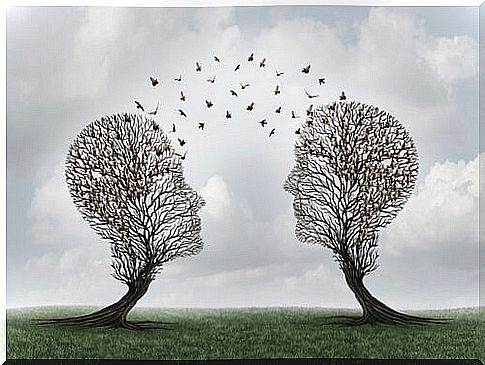What Is Social Cognition?

What is social cognition? Social cognition is nothing more than the study of the way we process information (Adolphs, 1999). This processing includes the way in which we encode, store and retrieve information from social situations.
Currently, social cognition is the dominant model and approach in social psychology. This arises in opposition to pure behaviorism, which rejected the intervention of mental processes when explaining behavior (Skinner, 1974).
Social cognition refers to the way we think about others. In this sense, it would be a powerful tool for understanding social relationships. Through social cognition we understand the emotions, thoughts, intentions and social behaviors of others. In social interactions, knowing what other people think and feel can be a huge advantage to get along in that context.

How does social cognition work?
People do not approach situations as neutral observers – although many times we try to pretend that we do – but we carry our own desires and expectations. These previous attitudes will influence what we see and remember.
In this way, our senses receive information that is interpreted and analyzed. Later, these interpretations are contrasted with the information that we keep in memory.
However, this simple description is not real. There are other factors, such as emotions, that also condition the process. Remember that thoughts influence emotions, but emotions also influence thoughts (Damasio, 1994). For example, when we are in a good mood, the world is (or seems) a happier place. When we are well we tend to perceive the present with more optimism, but we also look more positively at the past and the future.
How does social cognition develop?
Social cognition develops slowly (Fiske and Taylor, 1991). Follow a trial and error process based on observation. Direct experiences and exploration guide learning. However, social knowledge is very subjective. The interpretations that we can make of a social event can be very different and erroneous.
In addition, although we have mental structures that facilitate the processing and organization of information, sometimes these useful structures also betray us. The worst thing, when they do, is that …
These structures or schemas influence attention, encoding and information retrieval and can lead to self-fulfilling prophecy. This is a prediction that, once made, is itself the cause of its coming true (Merton, 1948).
On the other hand, social knowledge is, in part, independent of other types of knowledge. People with superior intellectual problem-solving skills need not also have superior social problem-solving skills. Problem-solving skills can be learned or taught separately from intellectual abilities. That is why improving intelligence, such as emotional or cultural, is so important.

Putting yourself in the perspective of others
One of the most useful models of social cognition is that of Robert Selman. Selman anticipated a theory about the ability to place oneself in the social perspective of others.
For this author, assuming the social perspective of others is the ability that gives us the power to understand ourselves and others as subjects, allowing us to react to our own behavior from the point of view of others. Selman (1977) proposes five stages of development for this social perspective:
- Stage 0: undifferentiated egocentric stage (3 to 6 years). Until this close to 6 years, children cannot make a clear distinction between their own interpretation of a social situation and the point of view of another. Nor can they understand that their own conception may not be correct.
- Stage 1: stage of taking a differential or subjective perspective, or informative-social stage (from 6 years to 8 years). Children of this age develop the knowledge that other people may have a different perspective. However, children have little understanding of the reasons behind the points of view of others.
- Stage 2: adopting a self-reflective perspective and taking a reciprocal perspective (8 to 10 years). Pre-teens, at this stage, take the perspective of another individual. Preteens are already capable of differentiating about the perspectives of others. They can also reflect on the motivations behind their own behavior from another person’s perspective.
- Stage 3: stage of taking a mutual perspective or a third person (10 to 12 years). Children can see their own perspectives, those of their peers, as well as those of a neutral third person. As third-person observers, they can view themselves as objects.
- Stage 4: stage of taking a deep individual perspective and within the social system (adolescence and adulthood). There are two characteristics that distinguish the conceptions of adolescents from other people. First, they become aware that motives, actions, thoughts, and feelings are shaped by psychological factors. Second, they begin to appreciate the fact that a personality is a system of traits, beliefs, values, and attitudes with its own evolutionary history.

Theory of mind
Linking with the previous section and as a component of social cognition, we find the Theory of Mind. In a review by Zegarra-Valdivia and Chino (2017) they affirm that “people have a complex metacognitive knowledge of their own mind as well as that of the minds of others, adding affective and cognitive aspects, in addition to the distinction between appearance and reality ” .
The Theory of Mind is a mental capacity, what does this mean? According to the authors, it offers different possibilities:
- Perceive mental states in other beings and recognize one’s own mental states as different from those of them.
- Differentiate some particular mental states from others.
- Attribute mental states using attributed states to explain and precede predictive and personal organizational behavior.
Two ways of looking at social cognition
Within psychology there are several ways of understanding social cognition. One of the most important emphasizes the social dimension of knowledge. Knowledge, according to this perspective, would have a socio-cultural origin, since it is shared by social groups.
The main exponent of this idea is Moscovici (1988), who spoke of “social representations”. These are ideas, thoughts, images, and knowledge that members of a community share. Social representations have a double function: knowing reality to plan action and facilitate communication.
Another perspective with great impact is that of the United States (Lewin, 1977). This way of understanding social cognition focuses on the individual and their psychological processes. According to this view, the individual builds his own cognitive structures from interactions with his physical and social environment.
As has been seen, social cognition is the way we handle the large amount of social information that we receive every day. The stimuli and data that we collect through the senses are analyzed and integrated into mental schemes, which will guide our thoughts and behaviors on subsequent occasions.
These schemes, once formed, are going to be difficult to change. Therefore, according to the phrase attributed to Albert Einstein, it is easier to disintegrate an atom than a prejudice. Our first impressions are going to be crucial, unless we start critical thinking that helps us develop a more efficient and reality-adjusted social cognition.
Bibliography
Adolphs, R (1999). Social cognition and the human brain. Trends in Cognitive Sciences 3: 469-79.
Damasio, AR (1994). Descarte’s error: Emotion, reason and the human brain. New York: Picador.
Fiske, ST and Taylor SE (1991). Social Cognition. McGraw-Hill, Inc.
Lewin, K. (1997). Resolving social conflicts: Field theory in social science. Washington, DC: American Psychological Association.
Merton, RK (1948). The self fulfilling prophecy. Antioch Review, 8, 195-206.
Moscovici, S. (1988). Notes towards a description of social representations. Journal of European Social Psychology, 18, 211–250.
Selman, RL, Jaquette, D. and Lavin, DR (1977). Interpersonal awareness in children: Toward an integration of developmental and clinical child psychology. American Journal of Orthopsychiatry, 47 , 264–274.
Skinner, B. (1974). On behaviorism. Barcelona: Fontanella.
Zegarra-Valdivia, J. and Chino, B. (2017). Mentalization and theory of mind. Neuropsychiatry Journal, 80 (3).









